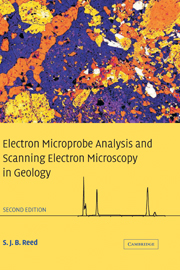9 - Sample preparation
Published online by Cambridge University Press: 03 December 2009
Summary
Initial preparation of samples
Most geological specimens require some preliminary treatment before mounting for examination in the SEM or analysis by EMPA. Often cleaning is necessary in order to eliminate unwanted contaminants. Sediments (and soils) commonly need drying. Friable and porous materials usually require impregnation, especially if polished samples are to be produced. Hand specimens have to be cut to a slice of an appropriate size for mounting and polishing. These processes are described in the following sections.
For further information on these and other aspects of specimen preparation the reader is referred to Humphries (1992), Laflamme (1990), Miller (1988), and Smart and Tovey (1982).
Cleaning
As collected, many samples contain unwanted components, which hinder examination of the specific features of interest and need to be removed. For example, sediments and soils often require washing with distilled water to remove soluble salts (mainly chlorides). Only gentle agitation should be used as a rule, ultrasonic cleaning being liable to damage the mineral grains. Unwanted carbonate can be removed with hydrochloric acid, iron oxides with stannous chloride and organic matter with potassium permanganate or hydrogen peroxide. Hydrocarbons can be removed by soaking in a solvent such as trichloroethane (pressure may be required in the case of low-porosity materials).
Drying
Some sample materials are wet in their normal state and must be dried. This can be carried out by gentle heating in air (temperatures above about 50 – can cause loss of structural water from clay minerals).
Information
- Type
- Chapter
- Information
- Publisher: Cambridge University PressPrint publication year: 2005
